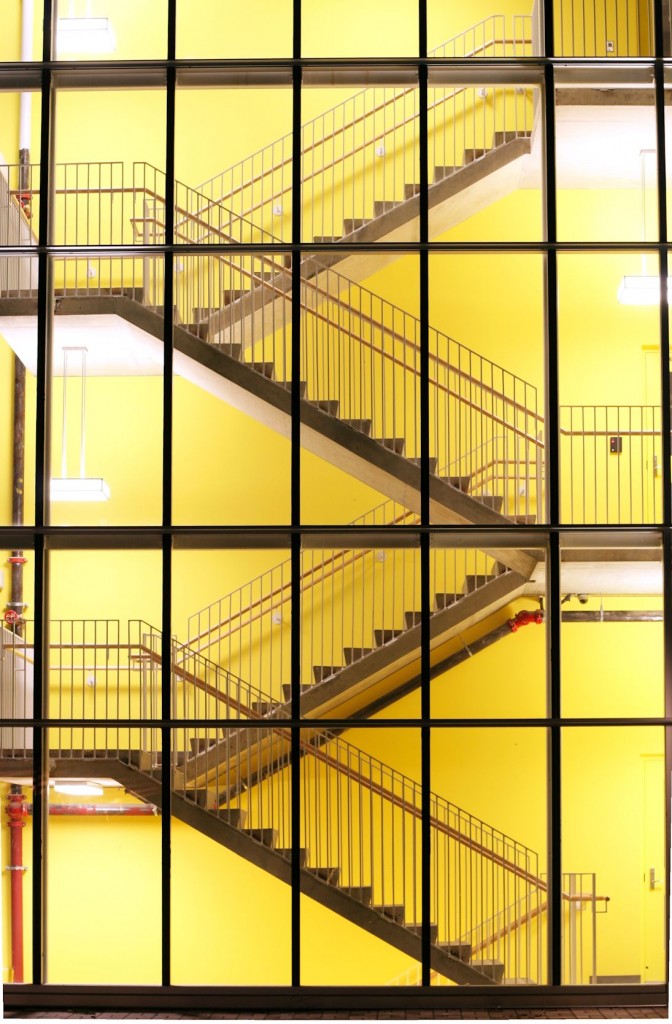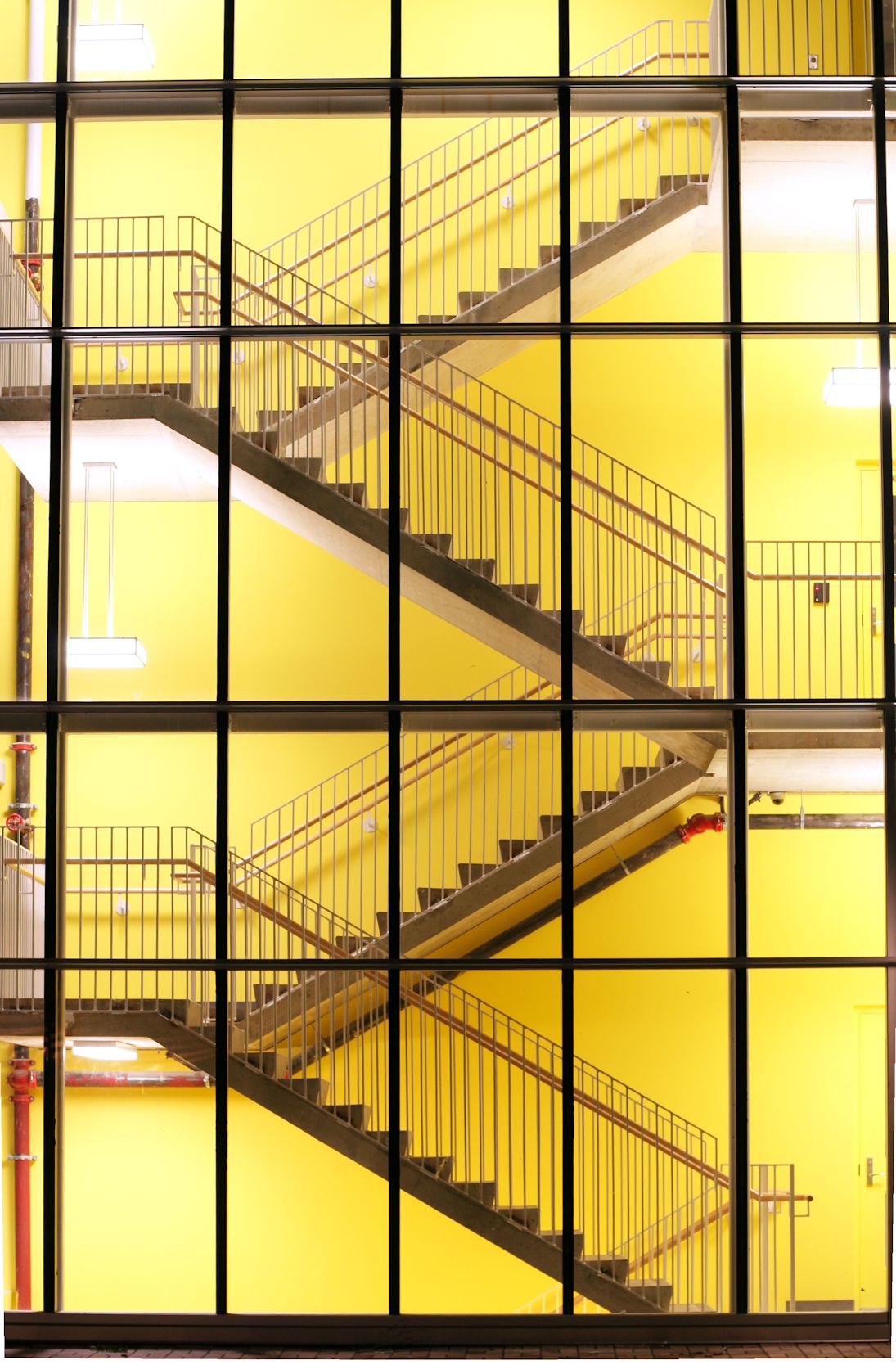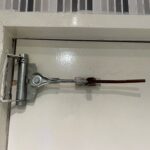 I don’t like surprises (except for the surprise package that I received from one of you last holiday season)…especially when it comes to codes. Even though the codes change every few years there’s usually plenty of time during the code development cycle to see the proposed changes, and then more time to get used to the changes before the new code is adopted.
I don’t like surprises (except for the surprise package that I received from one of you last holiday season)…especially when it comes to codes. Even though the codes change every few years there’s usually plenty of time during the code development cycle to see the proposed changes, and then more time to get used to the changes before the new code is adopted.
Something recently caught me by surprise and I feel like I should bring it to light so that anyone who is specifying, supplying, or installing electrified hardware on stairwell doors will be aware of the potential issue. This post might get lengthy, but stick with me, and feel free to pass it along to your colleagues.
In the 2012 edition of the International Building Code (IBC), stairwell reentry is addressed in section 1008.1.9.11 (see below). This section provides several options for locking stair doors on the stair side, with remote release via the fire command center. The requirements for stairwell reentry ensure that a building occupant can leave the stair if it becomes compromised by smoke, and also allows firefighter access from the stair into the building.
Exit discharge doors must provide free egress from the stair side but can be locked on the side opposite the stair side, according to the IBC. An exit discharge door would typically be the door that leads from the stairs to the exterior, an exit passageway, or a lobby. For stair doors other than the exit discharge, the options provided by this section are:
- Option A – stair doors that are openable from both sides – passage sets or fire exit hardware with non-locking lever trim on the stair side
- Option B – for stairs serving 4 stories or less, the doors can be locked on the stair side if they can be released without unlatching by a signal from the fire command center or a location inside the main entrance
- Option C – for buildings where a single exit stair is allowed (not very common), stair doors in some occupancies can be locked on the stair side with no requirement for remote release (new in 2012)
- Option D – doors arranged in accordance with section 403.5.3 (see below), which allows doors to be locked on the stair side if they can be unlocked simultaneously without unlatching via a signal from the fire command center – this section also requires a stairway communication system
Here’s the issue. Option A provides no security. Option B is limited to stairs serving 4 stories or less. Option C is very rare. And Option D refers to a section in the high-rise chapter of the IBC. So what happens when we have a stair serving more than 4 stories, but the building is not a high-rise? For example, a 5-story building that does not have an occupied floor more than 75 feet above the lowest level of fire department vehicle access (this is the IBC definition of a high-rise building), or a building with 3 stories above grade and 2 below.
If you asked me about this a few months ago (and some of you have), I would have recommended that you specify fail-safe electrified locks/fire exit hardware, and that the architect should discuss it with the code official to see if a stairway communication system would be required. But I recently ran into a different interpretation – that the IBC does not allow stair doors to be locked AT ALL if the building falls into this grey area between a 4-story stair and a high-rise, or that the AHJ may require additional measures beyond the stairway communication system.
On one side of the discussion are those who believe that because Option D references the high-rise chapter, it only applies to high-rise buildings, or buildings designed to meet ALL of the criteria for a high-rise. On the other side are those who point out that the reference in section 1008.1.9.11 only points to section 403.5.3, and doesn’t require compliance with the entire high-rise section.
A little history for those of you who are still reading…the 2003 edition of the IBC allowed stairs serving 4 stories or less to have locks on the stair side with no requirement for remote release. It also included the paragraphs that are in the high-rise section, allowing locks which could be unlocked remotely without unlatching. The 2003 IBC Commentary included the suggestion that “It would be reasonable to permit this arrangement in buildings other than high-rise buildings.”
In the 2006 edition of the IBC, the paragraph allowing mechanical locks on stairs serving 4 stories or less was changed to require remote release of those doors. At that point, the difference between the locking requirements for 4-story stairs and high-rise buildings was essentially the requirement for a stairway communication system. For anyone who is wondering what NFPA 101 says about this, The Life Safety Code still allows the use of mechanical locks on stairs serving 4 stories or less, and does not limit the use of electrified locks to high-rise buildings. It also includes parameters for “selected reentry,” which are not included in the IBC.
Of course, an AHJ (Authority Having Jurisdiction) can make the determination that the doors can be locked if remote unlocking (without unlatching) is provided, possibly requiring a stairway communication system or other safety measures. I will be working with the BHMA Codes & Government Affairs Committee to create a proposal for the 2018 IBC to help clarify this, but until then we should be prepared to have this discussion when a project falls into the grey area.
If you have experience or insight to share, I’d love to hear about it.
********************
From the 2012 IBC:
1008.1.9.11 Stairway doors. Interior stairway means of egress doors shall be openable from both sides without the use of a key or special knowledge or effort.
Exceptions:
1. Stairway discharge doors shall be openable from the egress side and shall only be locked from the opposite side.
2. This section shall not apply to doors arranged in accordance with Section 403.5.3.
3. In stairways serving not more than four stories, doors are permitted to be locked from the side opposite the egress side, provided they are openable from the egress side and capable of being unlocked simultaneously without unlatching upon a signal from the fire command center, if present, or a signal by emergency personnel from a single location inside the main entrance to the building.
4. Stairway exit doors shall be openable from the egress side and shall only be locked from the opposite side in Group B, F, M and S occupancies
where the only interior access to the tenant space is from a single exit stair where permitted in Section 1021.2.
5. Stairway exit doors shall be openable from the egress side and shall only be locked from the opposite side in Group R-2 occupancies where
the only interior access to the dwelling unit is from a single exit stair where permitted in Section 1021.2.
403.5.3 Stairway door operation. Stairway doors other than the exit discharge doors shall be permitted to be locked from the stairway side. Stairway doors that are locked from the stairway side shall be capable of being unlocked simultaneously without unlatching upon a signal
from the fire command center.
403.5.3.1 Stairway communication system. A telephone or other two-way communications system connected to an approved constantly attended station shall be provided at not less than every fifth floor in each stairway where the doors to the stairway are locked.
Photo: Shutterstock
You need to login or register to bookmark/favorite this content.







Great post as usual Lori! Thank you so much for what you do.
Thanks Jon!
Lori,
Thank you for the information, and yes I am one of the ones who kept reading the whole thing 🙂 . I just ran across this situation two weeks ago. An architect asked me the nearly identical question, and told me what the AHJ wanted. I was caught completely off guard. I am spreading the word among the architects I work with to be very careful, and to have a thorough discussion with the AHJ during design. Here in Salt Lake City we are starting to see a lot of buildings in this no man’s land where they are not quite high rise.
What did the AHJ want? A stairway communication system or something beyond that? There must be a big cost advantage for having a building just short of a high rise or with a larger portion below grade, because this specific issue is coming up a lot lately.
This is timely! Thanks so much!
You’re welcome Deb!
As I recall, they wanted remote unlocking.
As far as the advantages of not being a high rise, they are many. Here’s what you don’t have to do/have (I’m sure I’ll miss some): Fire command center; stairwell communications system; remote elevator monitoring/recall; stairwell pressurization; secondary water supply for fire sprinklers; elevator lobbies/elevator smoke protection; etc.
I would expect (and normally specify) remote unlocking for all stair doors, with VERY limited exceptions. I would even through in a stairway communication system in my hypothetical building since it is more than 4 stories but less than a high rise. But to add all of the items on your list to turn the building into the equivalent of a high rise? Not going to happen.
Lori
Apparently some AHJs are interpreting exception 2 to only apply to highrise buildings. If their interpretation is correct wouldn’t exception 2 state, “This section shall not apply to stairs in buldings constructed inaccordance with Section 403”? Also since the locking of stairway doors is explicitly permitted for high-rises per 403.5.3, this exception 2 is superfluous if it only applies to high-rises. They already have their exception in 403, and specific exceptions are meant to trump general requirements. Exception 2 explicitly refers to doors not buildings.
Unfortunately I think this first appeared in some form in the 2000 IBC, and that is, for me, a very difficult code cycle to track changes and research reasoning behind them. I don’t know how I could prove my interpretation, however reasonable, is correct. I have asked for help from ICC to obtain the code change reason.
sorry, I wasn’t clear. The laundry list was what you avoid by staying under the high rise.
I knew what you meant. But one of the interpretations I received was that ALL of the high rise requirements (everything on your list) would have to be met if the stair doors were going to be locked on a stair serving more than 4 stories, even if it was not a high-rise.
oh lord. That’s brutal!
Thanks, Lori for sharing. I always enjoy your code discussions. Have a great weekend.
Lori,
I found your blog in a search related to an experience I had a few days ago as a guest of a hotel in Tulsa, OK. I was at the Mayo Hotel, which was built in 1928 and restored a few years ago. Today it is both a hotel and a condo.
My room was on the seventh floor. I decided one evening to take the stairs down to the lobby, just to get a bit of exercise. The door was marked something to the effect of “Stairs – Fire Escape A” or some such. There was no “Caution: Door Locks on the Stair Side” or “No Reentry” disclaimer. So, I took the stairs down to the lobby and found the door locked on the stair side, which made me think, “Uh oh.” So, I went back upstairs and at each floor I checked the door and all of them were locked (up to the seventh floor). At that point, I was getting a bit panicky. I went back down to the lobby floor and saw that there was a red phone to call the “Fire Department,” but I wasn’t going to do that until I was sure I couldn’t find a way out. I then kept going downstairs and eventually found a door that opened into a gated parking lot (I assume for condo residents).
All in all, I was about 10 minutes late in meeting my colleagues in the lobby, but no one seemed to notice and I was too embarrassed to mention what had just happened.
I debated whether to tell the hotel staff about my adventure, but ultimately didn’t. Now I’m second-guessing myself about that decision. If the sign had indicated that the door would lock on the stair side, I wouldn’t have taken the stairs in the first place and wouldn’t have found myself in that predicament.
Should the fire exit signage at a hotel or high-rise apartment building include language about no reentry/door locks on stair side? My gut says it should be required.
Craig Dees
Hi Craig –
I’m sorry you had that experience…it has happened to me before too. The signage you mentioned is a good idea, but it is not required by the International Building Code or NFPA 101 – The Life Safety Code. NFPA 101 does have a requirement related to stairwell signage, but it is signage on the stair side, not the egress side as you’re entering the stair. Because of the phone, it sounds like the doors in the hotel have electrified locks which unlock during a fire alarm. Usually when you reach the ground floor there is an exit discharge that would have allowed you out of the stair – in your case it was into the parking garage which is a little unusual but with older buildings sometimes there are variations from the codes.
I think it’s worth mentioning your experience to the hotel and suggesting that they add signage. This can’t be the first time this has happened there.
– Lori
Although codes would probably need to change to allow it, what would you think of the following concept for a stairwell-security door:
When the door is unlocked, it would unlatch via stair-side latch-pull or crashbar, and indicators on both sides would conspicuously show that it was unlocked. It would also be expected to trigger a security-office indicator, though that wouldn’t be part of the fire-safety aspect.
To lock the door, it would need to be opened significantly, and then closed and latched while holding a button on the underside of the crashbar (opening the door would ensure that the person would be in a position to notice if there was any anyone trapped on the stairwell, or any imminent condition in the stairwell that might make it necessary for anyone to use the door as a means of egress; holding the button would ensure that the person wouldn’t accidentally lock themselves on the wrong side of it).
When the door was locked, a stair-side indicator would conspicuously show “LOCKED” and an egress-side indicator would show “Emergency Exit Only”. Operating the crashbar would unlock and unlatch the door, and would cause the door to remain unlocked unless or until the lock was reset via the procedure above.
Such a mechanism would ensure that anyone who attempted to exit via a door would be able to return the same way if the stairwell turned out to be impassible, but would not pose the security risks associated with allowing unauthorized persons to use a fire alarm as a means of obtaining access. Allowing a business to secure their premises from the egress side after confirming the stairwell was clear would help reduce any perceived need to secure the door via other improvised (unlawful and dangerous) methods.
What do you think of the idea? Do you know if any such things have been proposed, and if so what issues were raised?
Hi John –
I like the thought of removing the incentive to lock the doors illegally, but I think this would be a difficult code change to get approved. I have not seen something like this proposed, but usually the technical committee and the AHJs are looking for egress methods that are simple and foolproof. On the security side, if someone exited while the door was locked, it would then be unlocked for anyone to enter. The IBC does not require immediate release upon fire alarm – the stairwell doors are unlocked by the fire department when they arrive. There are pros and cons to this, but at least someone can’t pull the fire alarm and immediately enter the tenant space.
– Lori
Not sure if anyone can contribute, but well give it a shot. We have a five story building above grade, B use with three levels below grade. Below grade is parking garage and some tenant space. The elevators – three bays – exit on the lower level into a lobby. One needs to exit the lobby into the garage to get to the exit stair enclosure to go up to the exit. Is there a requirement for an exit enclosure so that one, if they came down in the elevator can get to a stair without entering the garage? Especially as the garage is below grade, not open deck. It seems to me that the elevator lobby should offer a protected path to and up the stair. The building is in the process of being fully sprinkled. Happy to offer more information or clarification. I am looking for some code sections to reference as to this requirement. Thanks.
Hi Ken –
I’m not sure…it does sound like there should be a protected path of travel to the exit, but the architect or AHJ should know.
– Lori
Hey, Lori,
Thanks for the article, it saved me a lot of research time, investigating the history of the requirement.
Any updates on your efforts to clarify the requirement in the !BC 2018?
-Dwight
Lori –
An issue came up recently about a high-rise building needing the communication system. 403.5.3.1 requires communication to an “approved, constantly attended station”. The project that this has come up on is a high-rise building and they know they need the communication system. However, the building is an office building that does not have a constantly-attended station within it nor does the building have 24-7 security/attendant staff.
Do you know if this constantly attended station is intended to be located within the building or could such a system connect to an off-site call center (such as the property management group’s maintenance hotline)?
Thanks!
Hi Michael –
Here’s what the IBC Commentary says:
“If the stairway doors are locked to restrict reentry as permitted in Section 403.5.3, a two-way communication system must be provided at no less than every fifth floor and must be connected to the standby power system. This system is required to be connected to a constantly attended location, which could be within the building, or to a central station that monitors fire alarms and is manned 24 hours a day, 7 days a week. Use of the fire command center is not recommended, since it may not be constantly attended. The system will permit occupants in the stairway to notify the attended location that the stairway doors need to be unlocked to access another floor or because conditions in the stairway prevent its continued use.”
– Lori